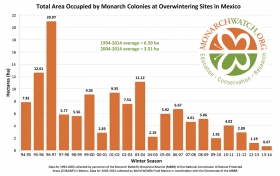Monarch Butterflies losing critical habitat

Sandy Oliviera has raised monarch butterflies in her East Providence backyard for 25 years. In 1998, she helped 125 monarch caterpillars transform into butterflies, and then released them to the wind.
"I began to feel like a butterfly factory that year," Oliviera said. Each time her husband or daughter collected milkweed to feed their captive caterpillars, they returned with more eggs or caterpillars to raise. Some days, Oliviera released a dozen newly emerged butterflies, to the pleasure of her 8-year-old grandson who let them rest on his head before they flew away.
This summer, for the first time, Oliviera hasn't found a single monarch egg or caterpillar, and hasn't seen any monarch butterflies.
Monarchs are amazing insects. Each March, after overwintering in the forested mountains of Central Mexico, they fan northward on a 3,000-mile journey to southern Canada. In late August, as the weather cools, they fly back to Mexico.
This annual migration is achieved through the efforts of multiple generations of monarchs. After leaving Mexico, the butterflies lay eggs in the southern United States before dying. Their offspring complete the migration north, where up to four more generations hatch, reproduce and die.
By fall, the monarch population can grow to be hundreds of millions strong, as they begin their migration south. How this younger generation of monarchs locates the same overwintering forests in Mexico each year, despite never having flown there before, remains a mystery.
Graph of Monarch overwintering area courtesy Monarch Watch.
Read more at ecoRI.
2014©. Copyright Environmental News Network